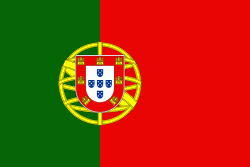Sines Municipality (Sines)
 |
The municipality is bordered to the north and east by the municipality of Santiago do Cacém, south by Odemira and west by the Atlantic Ocean. The coastline of the city, south of São Torpes, is part of the Southwest Alentejo and Vicentine Coast Natural Park.
Vestiges of a few settlements have today been discovered in archaeological sites, such as Palmeirinha and Quitéria, that attest to the age of human settlements in Sines. Arnaldo Soledade (1981) noted that these Visigoths, identified as Cinetos, may have been the original civilization that gave rise to the community, suggesting the local toponymy may have derived from this; Cinetos, to Cines and, finally, Sines. Although this tribes lineage is not clearly defined, Soledade goes on to refer to the construction of a castro where the current Castle stands.
The Punics are thought to have also had a presence in the area; a Punic artifact, the Tesouro do Gaio was unearthed in 1966, and is on display in the Museu de Sines (Sines Museum). Discovered in May 1966, the 'treasure' was unearthed by a local farmer, Francisco da Silva Campos, who was tilling his land to plant corn, and discovered a schist tomb with women's jewellery in his plot of land in Herdade do Gaio (12.5 km southeast of Sines, 7 km from the coast and 275m from Ribeira de Morgavel).
Between 1966 and 1967, investigator José Miguel da Costa discovered several of these Punic graves, but all showing evidence of early tomb raiding. While the jewellery was determined to be Punic in origin, the symbolism on the artefacts were characterized as Egyptian. On the island of Pessegueiro, there is also evidence of Ibero-Punic artefacts discovered under the Roman port, discovered by archeologists Carlos Tavares da Silva and Joaquina Soares (1981). Roman occupation brought the destruction of many of these artefacts associated with the Iron Age.
The Romans used Sines as a port and industrial centre; the bay of Sines was used as port by the civitas of Miróbriga and the canal on the island of Pessegueiro is linked to Arandis (Garvão). During Rome's occupation, Sines and the island of Pessegueiro, were poles within an industrialized fishing industry which included salting fish. The Roman centres were thought to have been at Praça Tómas Ribeiro, as well as the area around Monte Chaos in Feteira Cima (although little explored archaeologically). In the fields of Quitéria, Carlos Tavares da Silva and Joaquina Soares (1981) investigated the remains of a 1st-century villa, where the remnants of cobblestone streets and a hypocaust were discovered.
In 1961, José Miguel da Costa, during excavations around the Castle of Sines, discovered Roman "fishing factories", and a ceramics kiln to produce amphorae for salted fish, both dating back to the 1st and 2nd centuries. Sine's toponymy is also Roman in origin, but may refer to two terms (both applicable): the term sinus, which means bay; or an alternate meaning for curve, and may refer to the curvature of the Sines Cape, as seen from Monte Chãos.
Map - Sines Municipality (Sines)
Map
Country - Portugal
 |
 |
| Flag of Portugal | |
One of the oldest countries in Europe, its territory has been continuously settled, invaded and fought over since prehistoric times. The territory was first inhabited by pre-Roman and Celtic peoples who had contact with Phoenicians, ancient Greeks and Carthaginians. It was later ruled by the Romans, followed by the invasions of Germanic peoples and the Islamic invasion by the Moors, whose rule was eventually expelled during the Reconquista. Founded first as a county of the Kingdom of León in 868, gained its independence as the Kingdom of Portugal with the Treaty of Zamora in 1143.
Currency / Language
| ISO | Currency | Symbol | Significant figures |
|---|---|---|---|
| EUR | Euro | € | 2 |
| ISO | Language |
|---|---|
| PT | Portuguese language |















